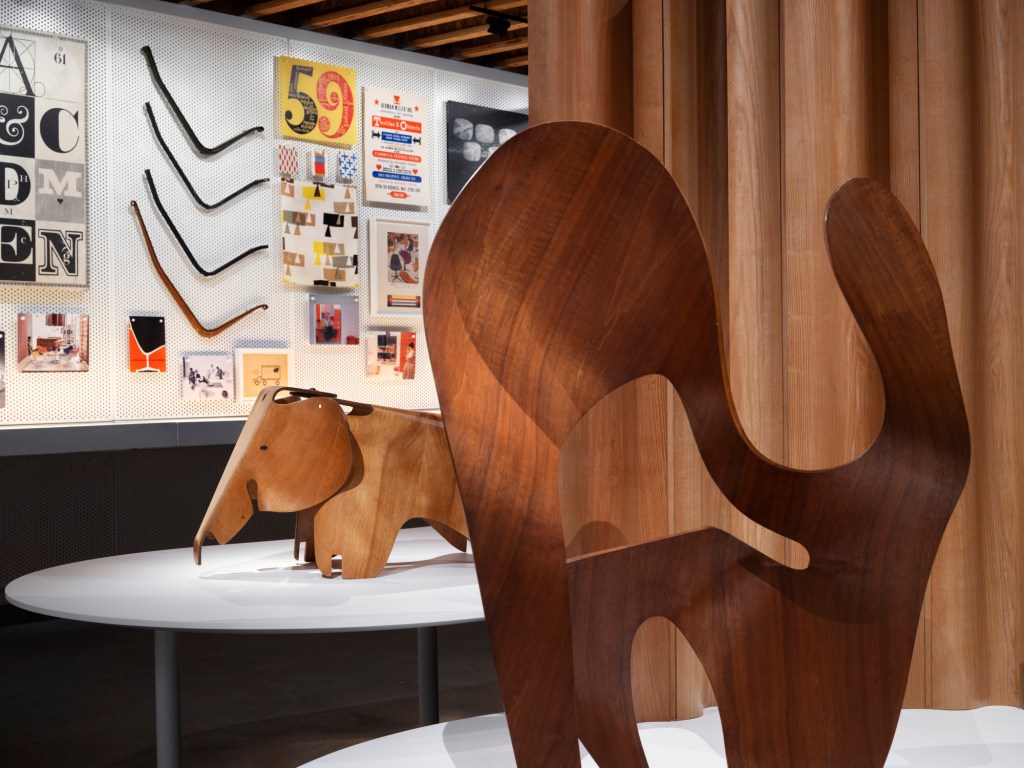Midcentury design trailblazers Charles and Ray Eames are inextricably linked to Los Angeles, where they lived and worked for 40 years at 901 Washington Boulevard in Venice, and where their Case Study home in the Pacific Palisades is an icon of modern architecture.
Yet it is in Northern California, in Richmond, that a new space dedicated to the designers’ process and problem-solving has opened, shedding light on the workings of the minds behind the lounge chair and ottoman, as well as the 1970s-era “Powers of Ten” film depicting the scale of the universe.
The Eames Institute of Infinite Curiosity’s gallery and collections opened to the public in February under the direction of head curator Llisa Demetrios, the youngest of five grandchildren of the designing duo, who met at Cranbrook Academy of Art in Bloomfield, Mich., and married in 1941.
Although much of the Eames’ materials, slides, images and prints went to the Library of Congress after they died, and the conference room and entrance of their home/headquarters were donated to art museums, Demetrios’ mother Lucia bundled up the rest of the office contents and moved them to her farm in Sonoma County.
Demetrios, a museum curator and artist herself, is now cataloging those contents and re-imagining her grandparents’ legacy with the nonprofit institute she founded in 2022, and its new exhibition space.
“The thing I learned very quickly from them is what they called ‘found learning.’ Just being around them and being at their office or at their home, you learn how they did things and how they solve problems,” she says during a recent tour, explaining her goal with the space is to impart some of that wisdom through storytelling by using the nearly 40,000 objects in the archives.
There are several cases with mementos that reveal what the designers were like from an early age, including two wonderful fashion sketches by Ray, who in 1933 earned a degree in fashion design from the Bennett School for Girls in Millbrook, N.Y. Although she largely transitioned to other areas of design, she continued to make hundreds of related sketches throughout her life, which the institute may some day show in their entirety. Also on view are her charming paper dolls, which she started making at age 3, and hand-drawn packing lists for trips with little drawings of her clothing, shoes and gloves.
All of it demonstrates how her color sense and whimsy were essential to the later work of designing textiles, clothing for herself and Charles, choir robes for a church, and uniforms for staff members of IBM’s Pavilion during the 1964 New York World’s Fair. “My favorite were her skirts which had 10 or 12 pockets. It was her tool kit, she kept her car keys, her Polaroid camera in there,” says Demetrios. “They also mended their clothes. Charles loved having his socks darned because he wanted them to last. There wasn’t a throwaway mentality at all.”

Charles came from an architecture background but was expelled from Washington University in St. Louis for embracing the modernism of Frank Lloyd Wright. His great friend, artist Saul Steinberg, found humor in the situation, and mocked up a fake diploma from the university, which would eventually award Charles an honorary degree. Pointing to the fake diploma “that says nothing fabulously,” Demetrios shares that it fooled her all her young life.
During the Depression, Charles went to Mexico and earned money to send home to his family by painting houses and making watercolors, some of which are here. “It’s on that trip he had an epiphany, which is how he put it, when he saw people with far less than he had who were far happier. And the reason was, as he looked at it, they were working on projects for their church, their community, their school, their town. That became a really important idea to him and evolved into how to approach what to design or not design,” Demetrios says of his less-is-more philosophy and the couple’s focus on design for the good of society as a whole.
It was that kind of thinking that led the Eames to eventually stop harvesting Brazilian rosewood for furniture when they heard about the impact on the forests, and to discontinue using plastic and fiberglass when they learned it was going in landfills, making them early proponents of sustainability.
A beautifully curated center display highlights some of the couple’s most important designs, including a set of four molded plywood seats — works in progress — that were forerunners to the famous Eames dining chairs, made by their Kazam! machine that used an inflatable rubber pouch to shape the wood. “The wood was not working the way they wanted it to, but they never called anything a failure, they called it a misconception and moved on,” says Demetrios, explaining how the misshapen seats are juxtaposed with the eventual perfected design, a chair split into two plywood pieces on a welded steel rod base.

“Today you can laser cut and do a molded plywood chair, but they worked within the constraints of what they had, which is another great lesson. Honest use of materials, hands-on, do not delegate understanding are all lessons that they learned from the very first project that they did together and it informed everything they did after,” she says.
Also on view: their innovative wood basket-like stretcher, used by ambulance crews during World War II, and a gorgeous 1943 plywood sculpture “that would give Richard Serra a run for his money,” as Demetrios put it, but was actually a test to push the limits of wood. A second sculpture just like it was exhibited in 1944 at MoMa’s 15th anniversary exhibition “Art in Progress: Design for Use,” flanked by Constantin Brancusi’s “Bird in Space” and an airplane propeller.
The entry room opens up into an industrial warehouse packed with shelves of furniture, much of it chairs in various iterations and colors — office chairs, dining chairs, lounge chairs — with cat’s cradle and Eiffel Tower inspired bases, for dentists’ offices, the 1964 World’s Fair IBM Pavilion and airport lounges, produced by Herman Miller and Vitra.
“Part of what we like to share here is not just the chairs, but the stories and the questions Ray and Charles asked in designing those chairs,” says Demetrios, pointing out the Eames’ design for airport seating.
“Their first question was always, ‘What’s wrong with what exists?’ So they went and talked to maintenance teams at about five airports. Now think ‘Mad Men’ era, and how much smoking happened. The biggest issue was replacement parts.”
The designers noticed existing seats were heavily upholstered, and new cushions took up a lot of storage, so they redesigned the seating to create a version where the back and the seat were the same shape, and the covering rolls up. “I call it the Ray and Charles Eames mending system; as opposed to replacing it, they just pushed it along a little farther.”

Several of the designers’ tools are on display, including a steel cabinet full of the miniature photographs of people they used for their scale models. “Everyone was asked to pose, everyone who came to the office, everyone from the factory. There usually was a day where ‘you were dressed for the city’ is how it was put,” Demetrios says of the hundreds upon hundreds of midcentury-dressed people. Another cabinet reveals meticulously organized colored pencils, and another decorative papers they used to cover light sockets.
Other items speak to the designers’ love of play, including letters written to their grandchildren in Rebus, ride-on toys, spinning tops, and Japanese-fish-on-a-string and more collected around the world over the years. Also charming: a 15-foot vertical xylophone that the Eameses designed for the Time-Life building lobby in Manhattan in the 1950s, which plays musical notes when a marble is dropped in the slot above.
The institute maintains the archives through online and temporary exhibitions, and is also responsible for Lucia Eames’ farm, the William Turnbill-designed Eames Ranch in Petaluma. The ranch is undergoing renovations and will be open to the public in the coming year, as the family moves toward having three spaces in the Bay Area: the ranch, the institute and a future Eames museum.
Tours of the archives end with a “chair tasting” where visitors can try out some of the famous designs, including a “couch but not a casting couch” created for their friend, the legendary filmmaker Billy Wilder.
“What we’re doing is taking Ray and Charles off the pedestal and sharing how in many ways, they were just solving problems that interested them,” says Demetrios. “What’s funny is we have a lot of the same problems today.”
The Eames Archives are open for public for guided tours by reservation and tickets can be purchased at eamesinsitutute.org.


